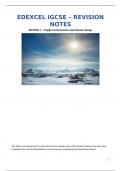EDEXCEL IGCSE – REVISION
NOTES
SECTION 7 – Fragile environments and climate change
N.B. These notes should not be misconstrued to be entirely what will be tested, however they have been
compiled in line with the Specification, using resources recognised by the Examination Board.
1
,Table of Contents – Fragile Environments
7.1 Fragile environments are under threat from desertification, deforestation and global climate change
a) Distribution and characteristics of the world’s fragile environments
b) Causes of desertification (drought, population pressure, fuel supply, overgrazing, migration) and
deforestation (commercial timber extraction, agriculture, mining, transport; settlement and HEP
(hydroelectric power)
c) Causes of natural climate change (Milankovitch cycles, solar variation and volcanoism) and how
human activities (industry, transport, energy and farming) can cause the enhanced greenhouse
effect.
7.2 There are various impacts of desertification, deforestation and climate change on fragile
environments
a) Social, economic and environmental impacts of desertification (reduced agricultural output,
malnutrition, famine, migration).
b) Social, economic and environmental impacts of deforestation (loss of diversity, contribution to
climate change, economic development and increased soil erosion).
c) Negative effects that climate change is having on fragile environments and people (rising sea
levels, more hazards, ecosystem changes, reduced employment opportunities, changing
settlement patterns, health and wellbeing challenges, including food supply).
7.3 The responses to desertification, deforestation and climate change vary depending on a country’s
level of development
a) How technology can resolve water-resource shortages in fragile environments under threat from
desertification.
b) Different approaches to the sustainable use and management of a rainforest in a named region to
limit the extent of deforestation.
c) Different responses to global warming and climate change from individuals, organisations and
governments in a named developed and a named emerging or developing country.
Specification
2
,7.1 (a) Distribution and characteristics of the world’s fragile environments
---
Distribution and characteristics of different fragile environments –
The fragility of an environment is related to the pressure that the planet endures. The ecological footprint is a
measure of the mark that humans cause the natural world. It takes into account how much land and sea is required to
provide us with water, energy and food per person to support our lifestyle. If the Earth’s resources were shared
equally, everyone could get 2 hectares of the globe.
Distribution and characteristics
Coral reefs
This environment is fragile because climate change can cause damage to it.
Pollution, rising sea temperatures, increased seawater acidity and human activity causes the reefs
to corrode.
The sea life looks for another place to live due to these impacts.
- Coral reefs are most commonly found in the Great Barrier Reef and North East Australia.
--
Desert margins
These environments are fragile because desertification can take place here, leading to the once-
productive land turning into desert-like landscape.
There are numerous conditions that catalyse this: lack of surface water, lack of vegetation, lack of
fertile soil, and lowering the water table. (If water is withdrawn from the ground at a rate faster
then it can replenish, then the water table is lower.)
The sea life looks for another place to live due to these impacts.
- Arid environments are often found on the margin of deserts like the Sahel and South Africa.
--
Tropical rainforest
This environment is fragile because the trees, animals and soil have adapted over millions of years
for these conditions and climate change is rapidly affecting this environment.
The soil is infertile and has adapted to collect minerals from the rain and the air.
The change in environments can lead to deforestation taking place.
- This environment is found in the Amazon Basin in South Africa.
--
Tundra (Cold)
Extremely cold conditions are needed to preserve the ice and wildlife.
Climate change is warming up the Earth and making these cold environments warmer.
This means that these environments are at risk of losing their conditions due to the warming of the
Earth.
- Tundra environments at risk are found in Alaska, Serbia, North Pole and South Pole.
3
,7.1(b) – Desertification
---
Desertification -
Causes of desertification:
Drought -
Severe lack of rainfall is a cause of desertification. Without rainfall, soil cannot capture and store the rain
- which makes the soil dry as there is no moisture.
~ This means that plants cannot grow or be produced; plants require water in order for photosynthesis to
take place.
~ The soil is very dry and exposed, leading to it being blown away by the wind.
~ The once-productive soil turns into desert-like conditions.
--
Population pressure -
Increases in population or the mass migration of people to a particular region means that there is a
greater demand for resources like food, water and wood.
~ The already-pressurised conditions undergo overgrazing and overcultivation. This wears out the soil,
meaning that there is a reduced water table.
~ This leads to fewer plants and farming as the soil is infertile.
~ Desertification takes place because the once-productive land turns into desert-like conditions.
--
Fuel supply-
Fuel wood is in high demand in desert/semi-arid conditions. When trees and vegetation are cleared for
fuel wood, the soil is left bare.
~ Since the soil is left bare after trees are cut down, it can get blown away easily by the wind.
~ When trees are uprooted, the roots of trees can no longer hold the soil together, causing erosion as it is
exposed.
--
Overgrazing -
Sheep, cattle and camels graze on grass. This is in a deficit of supply in the semi-arid conditions, so the
animals continuously graze on the same soil/same area.
~ This exploits the minerals and fertility of the soil, leading to desertification as the soil is under too much
stress.
--
Migration -
When the survivability in a particular region and/or desertification takes place in a particular region,
people migrate to another region in search for food and water.
~ Wherever they settle, there is an increased resource demand, which in turn means that the soil or
environment gets exploited.
~ This puts too much pressure on the soil, leading to infertility of the land.
~ There is also too much pressure on the environment, leading to overcultivation of that land.
7.1(b) – Desertification
---
Desertification -
Causes of desertification:
Commercial logging -
10% of deforestation is attributed to new infrastructures that serve the human lifestyle in 3 ways:
transportation, transformation and energy generation.
4
,~ Some developing countries encourage commercial logging because the revenue earnt from selling
timber, minerals and sources of medicinal drugs can fund economic developments + pay off debts.
--
Timber extraction -
Valuable trees (such as mahogany) are cut down due to their high-quality and demand. This process is
known as selective logging.
~ When these trees are chopped down, they damage other trees due to the pressure.
~ More damage is caused when clear-felling takes place - this is where other trees are chopped down so
they can be chipped for pulp.
--
Agriculture -
Trees are cut down to make space for agricultural plantation.
~ These plantations require space for numerous purposes:
Single crops (such as coffee and beans - primarily grown for export to relieve consumer demands
on developed countries like the USA.
Cattle (cows and sheep) require land to graze upon.
Fruits (tropical fruits like pineapple) are grown here to be exported due to high demand.
~ Numerous agricultural activities take place on the land of rainforests as it is cheap to purchase this land
due to the extensive work required to clear it.
--
Mining -
Large areas of forest are cleared for open-cast mining for minerals such as iron, copper and gold. Due to
rising demands for minerals and increasing prices, mining projects tend to take place in
rainforests/copses of trees in developing Countries. This is because taxes are low.
~ Due to the rising demand for minerals and the continuously increasing prices, mining projects tend to
take place in rainforests/copses of trees in developing countries. This is because taxes are low, therefore
the production costs are minimal.
~ Governments may not regulate resource consumption and this means the abundance of resource located
here can be exploited.
~ Mining in this location carries risks and other damages; a major construction infastructure is established
for high-income:
Roads have to be created for access of heavy goods vehicles meaning trees need to be cut down.
Railway lines have to be created to increase the ease of transporting materials.
Power stations may have to be created in order to power machinery.
--
Transport -
International lending institutions like the World Bank provide money to the national Government for
large-scale projects, which often entail transportation systems.
~ The transportation of timber. Coil, oil, biomass and natural gases require large transport infrastructures,
which often necessitates the clearing of forests.
--
Settlement -
The population shift that is leading people to move from rural areas to urban areas contributes to
deforestation.
~ The urban growth means that there is a greater demand for houses and consumption sites.
~ When cities get larger or people are looking for a place to live, they often expand into forests due to the
availability of resources.
--
Hydroelectric Power -
Large hydroelectric projects means that rivers get dammed to allow for the production of renewable
energy.
~ This often means that water is collected in areas due to the reduced flow of water.
5
, ~ The reduction in water flow means that it can get collected up, and lead to flooding in forest areas.
~ Flooding can damage the soil and the trees, leading to deforestation taking place.
3.1(c) – Causes of volcanic and earthquake hazards, including the role of
plate boundaries and hotspots
---
Natural climate change -
There are numerous causes of climate change:
Milankovitch Cycles -
Orbital changes are the orbit tilting slightly on an axis that is circular, wobbling like a spinning top about
to fall. Cold glacial periods and ice ages were 5-6 degrees colder than today. These changes affect where
sunlight falls on the Earth's surface.
~ An example is the Earth's rotation changing from being a circular rotation to an eclipse over 100,000
years ago.
~ In the Southern Hemisphere (near Australia), the tropical cyclone season runs from November to April.
--
Solar Variation -
There are black spots on the surface of the sun, which shows where the sun is more active than usual.
More sports means more solar energy being fired out from the Sun towards Earth. These hotspots have
increased temperatures by 1-2 degrees. Changes in the tilt of the Earth's axis (obliquity), slight tilts as the
Earth spins on its axis (precession) and the eccentricity in the shape of the Earth's orbit around the sun
are the causes of variation in the amount of solar radiation recieved by the Earth.
~ Variations were observed by astronomers in 1947 during the Greatest Sunspot. This was the largest
recorded sunspot, measuring around 30% the size of Earth.
--
Volcanoism -
The blanket of ash from volcanoes blocks the rays of sun from reaching the surface of the Earth. The rays
of the sun are reflected off the ash and gas to go back into space. The radiation that does not enter the
Earth means the planet cools down and the average temperature decreases - increasing the possibility
for a glacial period.
~ A Little Ice Age was caused by a large volcanic eruption in 1257.
6





